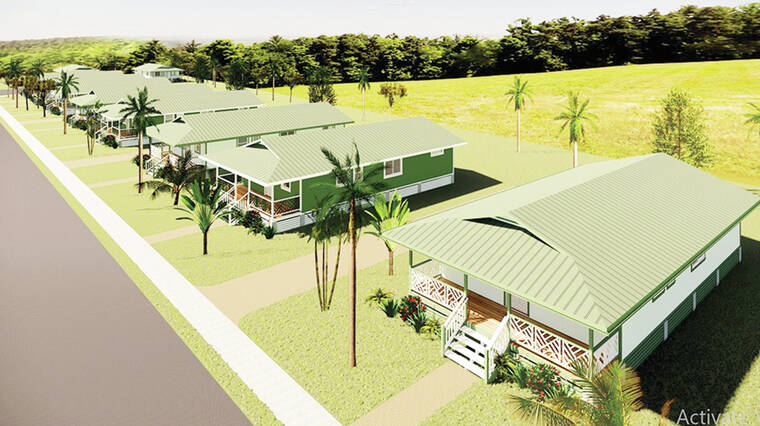LIHU‘E — Over the course of 2023, the County of Kaua‘i and its private development partners expect to break ground on 400 new affordable apartments and homes that will eventually house more than 1,000 people.
These developments — a range of one-, two- and three-bedroom units — will be sprouting up in all corners of the island.
In ‘Ele‘ele, the county and private developer Ahe Group will begin construction on 149 units of the long-planned Lima Ola development.
In Lihu‘e, the Uahi Ridge multi-family housing project and Rice Street mixed use, multi-family housing project will create 94 and 66 apartments, respectively.
Habitat for Humanity has 32 units under construction at the Waimea Huakai single-family development, and the Kai Olina project will bring 45 new apartments to Port Allen.
On the North Shore, nonprofit Permanently Affordable Living Kaua‘i is set to begin construction of 11 single-family homes in Kilauea. Originally slated to break ground in January, an issue with water pipes has pushed construction back until summer.
Each project is expected to be completed within one to two years, and most will target families making 60 percent of the area median income or below, or $68,400 for a family of four.
County Housing Agency Director Adam Roversi attributed the proliferation of new affordable housing construction to “a perfect storm” of two factors.
“One, our private partners have been far more successful at getting state funds this year,” said Roversi. “Two, the Lima Ola project is finally breaking ground. That’s been many years in the making.”
Among the projects at the large-scale Lima Ola development is the Kealaula II site, which will provide supportive housing to 26 families transitioning out of homelessness. A pilot version of this project at the Pua Loke development in Lihu‘e, Kealaula I, opened in 2020.
“Our goal is to have a similar supportive housing project in every community,” said Roversi. “I think it will go a long way to addressing homelessness in a meaningful way.”
Kaua‘i currently faces astronomically high rents and home prices, with median home prices consistently hovering around the million-dollar mark this year. That contributes to a large homeless population, with an estimated 444 homeless individuals on island, according to the Point-In-Time survey conducted earlier this year.
While the infusion of new houses and apartments will help get many families into places they can afford to live, the effect on the housing market at large is unclear.
“It won’t have an effect on for-sale housing costs, because those are kept high mostly by off-island buyers,” said Roversi. “It might have an effect on rental costs. Then again, that depends on a lot of moving pieces.”
Funding affordable development
The cost of these projects — shouldered by the federal, state and county governments, along with developers, renters, and homebuyers — will total an estimated $231 million.
Three private developments, the Kai Olino, Rice Street and Uahi Ridge projects, all benefited from state and federal funds in the form of low-income tax credits, tax-exempt bonds and cash from the Rental Housing Revolving Fund this year.
These funds are awarded by the state in a competitive process that has often left Kaua‘i out in the cold.
Over the past decade, Kaua‘i has received less than $16 million from these funding sources, consistently getting less than its share compared to other counties even when accounting for relative population size.
But in 2022 alone, as the state Legislature increased the size of the rental housing revolving fund and Kaua‘i projects were more successful in the application process, the state doled out nearly $100 million to Kaua‘i projects.
“I’m really happy that developers have been able (to) secure low-income-housing tax credits and rental housing revolving funds to make these projects pencil out,” said Kaua‘i state Rep. Nadine Nakamura, who served as House Housing Committee chair in the last session and now serves as majority leader. “Without these funds, it doesn’t happen.”
Nakamura said the large allocation to the rental housing revolving fund ($300 million this year) was key to increasing housing construction statewide.
“I’m hopeful we can continue this level of funding,” she said. “This is the only way we can make a dent in the affordable housing shortage.”
As the county seeks to build more to address the housing crisis, they also hope to develop different ways of financing these projects.
For a portion of the Lima Ola development, the county borrowed money from the state, rather than going through the competitive application process. This year, it issued tax-exempt private activity bonds for the first time in decades to fund other sections of the Lima Ola project.
“Our hope is that we can continue to fund developments ourselves so we’re not entirely dependent on the annual competitive funding process from the state,” said Roversi. “So much of federal and state funding is just keeping your fingers crossed.”
Importantly, different sources of funding give the county more freedom to target different income levels, allowing for the creation of mixed-income housing. Stipulations attached to state and federal funding sources make these sorts of housing developments impossible on projects financed by these sources.
“From a policy perspective, that’s exactly what we strive for,” said Roversi of mixed-income housing. “It makes for a healthier community.”
•••
Guthrie Scrimgeour, reporter, can be reached at 808-647-0329 or gscrimgeour@thegardenisland.com.



